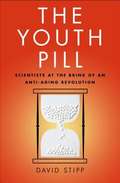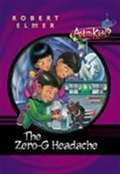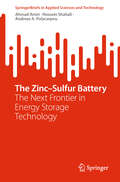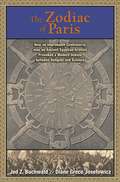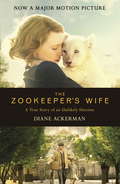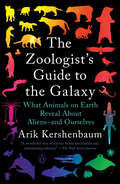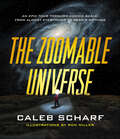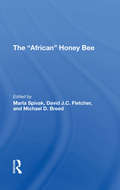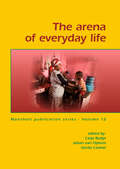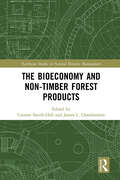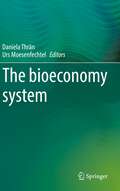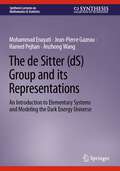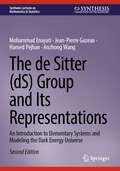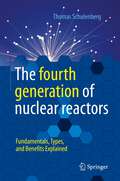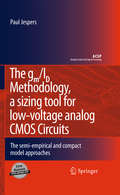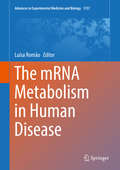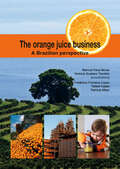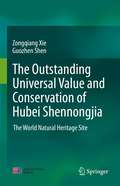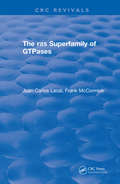- Table View
- List View
The Youth Pill
by David StippLiving longer is closer than we think. Even before the first person set off to find the Fountain of Youth, we were searching for a way to live longer. But promises of life extension have long reeked of snake oil, and despite our wishful thinking—not to mention the number of vitamins we pop—few of us believe we’ll live to see one hundred, much less set a longevity record. But now scientists are closing in on true breakthroughs in anti-aging. Compounds that dramatically extend the health spans of animals, including mammals, have recently been demonstrated in the lab, and gerontologists now generally agree that drugs that slow human aging and greatly boost health in later life are no longer a distant dream. David Stipp, a veteran science journalist, tells the story of these momentous developments and the scientists behind them, providing a definitive, engaging account of some of the most exciting (and sometimes controversial) advances that promise to change the way we live forever. .
The Yucky Reptile Alphabet Book (Jerry Pallotta's Alphabet Books)
by Jerry PallottaFind out why boa constrictors swallow their meals whole, learn why gila monster's tails are so fat, and meet a lizard that is larger than most people.As young readers turn the pages of this beautifully illustrated book, they will find that reptiles aren't really so "yucky." In fact, reptiles are among nature's most exotic and intriguing animals.Jerry Pallotta's well-researched text and Ralph Masiello's vivid illustrations will enthrall young and not-so-young readers alike.
The Zebrafish: Atlas of Macroscopic and Microscopic Anatomy
by Lester J. Layfield Joseph A. Holden Jennifer L. MatthewsThe zebrafish (Danio rerio) is a valuable and common model for researchers working in the fields of genetics, oncology and developmental sciences. This full-color atlas will aid experimental design and interpretation in these areas by providing a fundamental understanding of zebrafish anatomy. Over 150 photomicrographs are included and can be used for direct comparison with histological slides, allowing quick and accurate identification of the anatomic structures of interest. Hematoxylin and eosin stained longitudinal and transverse sections demonstrate gross anatomic relationships and illustrate the microscopic anatomy of major organs. Unlike much of the current literature, this book is focused exclusively on the zebrafish, eliminating the need for researchers to exclude structures that are only found in other fish.
The Zero-G Headache (AstroKids #2)
by Robert ElmerMeet the AstroKids--DeeBee, Buzz, Miko, Mir, and Tag--five friends learning biblical truth through out-of-this-world adventures aboard space station CLEO-7. "'DeeBee's a GEEN-ius.' Suffering satellites, that's all I ever hear! So I understand basic quantum theory. I mean, who doesn't, right? "Anyway, can you believe it? Zero-G, The most popular band in the galaxy, was coming to perform at CLEO-7. Now. . . I think Zero-G's music is pretty lame -- but don't tell that to the other AstroKids! I was more interested in finding out why my geeky cousin Phil was on Zero-G's shuttle. . . and what exactly he was hiding in that mysterious blue plasma barrel".
The Zinc–Sulfur Battery: The Next Frontier in Energy Storage Technology (SpringerBriefs in Applied Sciences and Technology)
by Ahmad Amiri Hossein Shahali Andreas A. PolycarpouThe book starts with a foundational overview, providing readers with insights into the evolution of battery technology and the historical backdrop that has shaped the landscape of zinc-sulfur batteries before looking into their chemistry and construction. Readers are guided through the fundamentals of battery chemistry, exploring electrochemical principles, key components, and the basic reactions that underpin zinc-sulfur batteries. The book explains design considerations, from cell components and materials to electrode configurations as well as charge and discharge processes, cycling behavior, and considerations of capacity and efficiency. It summarizes recent advances and research trends. Applications of zinc-sulfur batteries are reviewed: from electronics to electric vehicles, renewable energy storage, and military and aerospace applications including real-world case studies. Supplemented by appendices containing a glossary of terms, references, abbreviations, and an index, This book is a definitive resource for researchers, practitioners, and enthusiasts seeking to unravel the complexities and capitalize on the potential of this transformative energy storage technology.
The Zodiac of Paris: How an Improbable Controversy over an Ancient Egyptian Artifact Provoked a Modern Debate between Religion and Science
by Jed Z. Buchwald Diane Greco JosefowiczThe clash of faith and science in Napoleonic FranceThe Dendera zodiac—an ancient bas-relief temple ceiling adorned with mysterious symbols of the stars and planets—was first discovered by the French during Napoleon's campaign in Egypt, and quickly provoked a controversy between scientists and theologians. Brought to Paris in 1821 and ultimately installed in the Louvre, where it can still be seen today, the zodiac appeared to depict the nighttime sky from a time predating the Biblical creation, and therefore cast doubt on religious truth. The Zodiac of Paris tells the story of this incredible archeological find and its unlikely role in the fierce disputes over science and faith in Napoleonic and Restoration France.The book unfolds against the turbulence of the French Revolution, Napoleon's breathtaking rise and fall, and the restoration of the Bourbons to the throne. Drawing on newspapers, journals, diaries, pamphlets, and other documentary evidence, Jed Buchwald and Diane Greco Josefowicz show how scientists and intellectuals seized upon the zodiac to discredit Christianity, and how this drew furious responses from conservatives and sparked debates about the merits of scientific calculation as a source of knowledge about the past. The ideological battles would rage until the thoroughly antireligious Jean-François Champollion unlocked the secrets of Egyptian hieroglyphs—and of the zodiac itself. Champollion would prove the religious reactionaries right, but for all the wrong reasons.The Zodiac of Paris brings Napoleonic and Restoration France vividly to life, revealing the lengths to which scientists, intellectuals, theologians, and conservatives went to use the ancient past for modern purposes.
The Zookeeper's Wife: An unforgettable true story, now a major film (Movie Tie-in Editions Ser. #0)
by Diane AckermanIn war-torn Warsaw, a zookeeper and his wife refuse to surrender... Now a major motion picture starring Jessica Chastain and Daniel Brühl, Diane Ackerman's The Zookeeper's Wife is based on a remarkable true story of bravery and sanctuary during World War II. Perfect for fans of Lion and Hidden Figures. 'I can't imagine a better story or storyteller. The Zookeeper's Wife will touch every nerve you have' -Jonathan Safran Foer, author of Everything is Illuminated When Germany invades Poland, Luftwaffe bombers devastate Warsaw and the city's zoo along with it. With most of their animals killed, or stolen away to Berlin, zookeepers Jan and Antonina Zabinski begin smuggling Jews into the empty cages.As the war escalates Jan becomes increasingly involved in the anti-Nazi resistance. Ammunition is buried in the elephant enclosure and explosives stored in the animal hospital. Plans are prepared for what will become the Warsaw uprising. Through the ever-present fear of discovery, Antonina must keep her unusual household afloat, caring for both its human and animal inhabitants - otters, a badger, hyena pups, lynxes - as Europe crumbles around them.Written with the narrative drive and emotional punch of a novel, The Zookeeper's Wife is a remarkable true story. It shows us the human and personal impact of war - of life in the Warsaw Ghetto, of fighting in the anti-Nazi resistance. But more than anything it is a story of decency and sacrifice triumphing over terror and oppression. What readers are saying about The Zookeeper's Wife: 'Beautifully and sensitively written - a must read''An adventure that inspires''Both horrifying and endearing on a scale I've not experienced in years''A story that will haunt you forever''Haunting, life affirming, sad, and inspiring'
The Zoologist's Guide to the Galaxy: What Animals on Earth Reveal About Aliens--and Ourselves
by Arik KershenbaumFrom a noted Cambridge zoologist, a wildly fun and scientifically sound exploration of what alien life must be like, using universal laws that govern life on Earth and in space.Scientists are confident that life exists elsewhere in the universe. Yet rather than taking a realistic approach to what aliens might be like, we imagine that life on other planets is the stuff of science fiction. The time has come to abandon our fantasies of space invaders and movie monsters and place our expectations on solid scientific footing.But short of aliens landing in New York City, how do we know what they are like? Using his own expert understanding of life on Earth and Darwin's theory of evolution--which applies throughout the universe--Cambridge zoologist Dr. Arik Kershenbaum explains what alien life must be like: how these creatures will move, socialize, and communicate. For example, by observing fish whose electrical pulses indicate social status, we can see that other planets might allow for communication by electricity. As there was evolutionary pressure to wriggle along a sea floor, Earthling animals tend to have left/right symmetry; on planets where creatures evolved in midair or in soupy tar, they might be lacking any symmetry at all.Might there be an alien planet with supersonic animals? A moon where creatures have a language composed of smells? Will aliens scream with fear, act honestly, or have technology? The Zoologist's Guide to the Galaxy answers these questions using the latest science to tell the story of how life really works, on Earth and in space.
The Zoomable Universe: An Epic Tour Through Cosmic Scale, from Almost Everything to Nearly Nothing
by Caleb ScharfAn epic, full-color visual journey through all scales of the universeIn The Zoomable Universe, the award-winning astrobiologist Caleb Scharf and the acclaimed artist Ron Miller take us on an epic tour through all known scales of reality, from the largest possible magnitude to the smallest. Drawing on cutting-edge science, they begin at the limits of the observable universe, a scale spanning 10^27 meters—about 93 billion light-years. And they end in the subatomic realm, at 10^-35 meters, where the fabric of space-time itself confounds all known rules of physics. In between are galaxies, stars and planets, oceans and continents, plants and animals, microorganisms, atoms, and much, much more. Stops along the way—all enlivened by Scharf’s sparkling prose and his original insights into the nature of our universe—include the brilliant core of the Milky Way, the surface of a rogue planet, the back of an elephant, and a sea of jostling quarks.The Zoomable Universe is packed with more than 100 original illustrations and infographics that will captivate readers of every age. It is a whimsical celebration of discovery, a testament to our astounding ability to see beyond our own vantage point and chart a course from the farthest reaches of the cosmos to its subatomic depths—in short, a must-have for the shelves of all explorers.
The african Honey Bee
by Michael D Breed Marla Spivak David J FletcherThis book is the first review of the scientific literature on the Africanized honey bee. The African subspecies Apis mellifera scutellata (formerly adansonii) was introduced into South America in 1956 with the intent of cross-breeding it with other subspecies of bees already present in Brazil to obtain a honey bee better adapted to tropical conditions. Shortly after its introduction, some of the African stock became established in the feral population around Sao Paulo, Brazil, and spread rapidly through Brazil. It has since migrated through most of the neotropics, displacing and/or hybridizing with the previously imported subspecies of honey bees. Africanized bees have been stereotype d as having high rates of swarming and absconding, rapid colony growth, and fierce defensivebehavior. As they have spread through the neotropics they have interacted with the human population, disrupting apiculture and urban activities when high levels of defensive behavior are expressed.
The arena of everyday life
by Carja Butijn Gerda Casimir Johan Van OphemIn 'The arena of everyday life' nine authors look back and forward at developments in the sociology of consumers and households. Nine chapters show variety in the employed methods, from multivariate analyses of survey data to classical essays. The contributions are organised around four themes. In the first theme, two chapters entail a critical discussion of the concepts livelihood and household. The second part deals with health, in particular food security, hygiene and aids/HIV. The third theme focuses on female opportunities to foster income procurement of household by respectively microfinance and entrepreneurship. The fourth theme concentrates on two topical societal developments in a Western society, the first chapter dealing with the issue of creating opportunities for tailor-made services to older people, the second one focussing on the home-work balance of telecommuters. This publication, written by international researchers, once supervised by prof. Anke Niehof, while writing their PhD dissertation, or (former) colleagues of Niehof, covers the many issues and reflecting her work and interest. The arena of everyday life is what her research and teaching evolved around, as shown in this book.
The bioeconomy and non-timber forest products (Earthscan Studies in Natural Resource Management)
by Carsten Smith-Hall James L. ChamberlainThis book provides the first in-depth investigation of how non-timber forest products are an integral part of local, national, and global bioeconomies. While the plants and fungi that produce non-timber forest products are essential to the sustainability of forest ecosystems, peoples' food and livelihood security and sovereignty, and thus the bioeconomy, are often absent from bioeconomic strategies. Presenting a selection of empirical cases from around the world that engage with the bioeconomy and non-timber forest products, this volume reveals how essential these products are to creating a greener and more sustainable future, how to to better integrate them into efforts to transition to and expand the bioeconomy, and how such efforts can be supported and developed. Chapters analyse how and to what degree non-timber forest products promote sustainable resource use, generate employment, and contribute to food and livelihood security and poverty alleviation. The volume develops approaches and identifies interventions and policies to support the integration of non-timber forest products into bioeconomy strategies, including in national reporting schemes to provide recommendations for future research and practical implementation. This book will be of great interest to students and scholars of forest and natural resource management, bioeconomics, circular economy and ecological economics more widely. It will also be of interest to professionals working in sustainable development and the forestry sector.
The bioeconomy system
by Daniela Thrän Urs MoesenfechtelThis book is a concise overall view of the status quo of the bioeconomy and its future developments - in Germany and beyond. Numerous practitioners from business, science, civil society and politics show how the bioeconomy is addressing the global problems of the future. Based on renewable raw materials and energies, the bioeconomy is developing new products and processes with the aim of shaping a more ecologically and economically sustainable future. But can it succeed? What are its opportunities and limitations? Which framework conditions influence it? The book answers these questions with a systemic view of the bioeconomy and thus enables a quick orientation in this topic. This is additionally supported by numerous graphics. The book thus invites readers to help shape the future of the bioeconomy.
The creature department.: La fábrica de inventos tras la penúltima puerta del final del pasillo (The\creature Department Ser. #1)
by Robert Paul WestonUn laboratorio escondido.Un increíble invento.Y unas criaturas bastante inusuales...Elliot y Leslie creían que en Bickleburgh nunca pasaba nada. Bueno, excepto dentro de la Denki-3000: la quinta compañía tecnológica más grande del mundo.Tras sus torres de cristal y pasadizos elevados hay una vieja mansión de la que surgen los inventos más increíbles que puedas imaginar. Y sólo el tío Archie sabe lo que en realidad esconde la penúltima puerta al final del pasillo.Claro, hasta que Elliot y Leslie echan un vistazo adentro... Tentáculos, criaturas con aspecto de trol y dientes rotos. Seres con alas enanas que chisporrotean al volar... ¡Pero atentos! El secreto mejor guardado de la Denki-3000 corre peligro, y Elliot, Leslie y las extrañas criaturas no tienen un segundo que perder. Tic, tac, tic, tac...Una aventura llena de humor con personajes divertidos y cercanos.Con excéntricas ilustraciones.La crítica ha dicho...«Impresionante... Es como si tomaras un poco de la película de Charlie y la fábrica de chocolate y Monsters Inc., y lo metieras en una nave como la tardis.» Buzz Feed«Weston destaca en cuanto al desarrollo de personajes de monstruos, y su imaginación va a toda velocidad, muy disfrutable.» Quill and Quire«Aunque esta deliciosa novela se concibió para niños de entre 8 y 12 años, cualquier persona con sensibilidad la disfrutará.» Library Journal«De un ritmo ágil, el estilo de Weston está repleto de agudo humor y conversaciones inteligentes.» University of Manitoba Library Association
The de Sitter: An Introduction to Elementary Systems and Modeling the Dark Energy Universe (Synthesis Lectures on Mathematics & Statistics)
by Jean-Pierre Gazeau Mohammad Enayati Hamed Pejhan Anzhong WangThis book reviews the construction of elementary systems living in de Sitter (dS) spacetime, in both the classical and quantum senses. Field theories on dS spacetime are among the most studied mathematical models of the Universe, whether for its earlier period (inflationary phase) or for its current phase of expansion acceleration (dark energy or cosmological constant). Classical elementary systems are Hamiltonian phase spaces, which are associated with co-adjoint orbits of the relativity group. On the other hand, quantum elementary systems are associated with (projective) unitary irreducible representations of the (possibly extended) relativity group (or one of its covering). This study emphasizes the conceptual issues arising in the formulation of such systems and discusses known results in a mathematically rigorous way. Particular attention is paid to: “smooth” transition from classical to quantum theory; physical content under vanishing curvature, from the point of view of a local (“tangent”) Minkowskian observer; and thermal interpretation (on the quantum level), in the sense of the Gibbons-Hawking temperature. Such a mathematical construction is of paramount importance to the understanding of the early Universe (due to the critical role that the dS metric plays in the inflationary cosmological scenarii) as well as to the construction of possible models for late-time cosmology (since a small positive cosmological constant or dark energy seems to be required by recent data). In this sense, this book uniquely blends mathematical physics (spacetime symmetry on classical and quantum levels) and theoretical physics (quantization, quantum field theory, and cosmology). Moreover, the level of exposition varies in different parts of the book so that both experts and beginners alike can utilize the book.
The de Sitter: An Introduction to Elementary Systems and Modeling the Dark Energy Universe (Synthesis Lectures on Mathematics & Statistics)
by Jean-Pierre Gazeau Mohammad Enayati Hamed Pejhan Anzhong WangThis Second Edition is a comprehensive update, integrating the latest research and theoretical advancements in the field of de Sitter (dS) group representations. Building on the success of the first edition, the book offers a more in-depth analysis of mathematical aspects, conceptual foundations, and practical implications related to the dS group, including its Lie manifold, Lie algebra, and co-adjoint orbits, viewing the latter as potential classical elementary systems within the context of dS spacetime. Additionally, the examination of unitary irreducible representations (UIRs) sheds light on the potential existence of quantum elementary systems within the dS spacetime framework. The authors emphasize consistency with Wigner's approach to elementary systems, incorporate Wigner's principles and exploring projective UIRs of the dS group, and provide a deeper insight into the nature of dS elementary systems. Particular attention is paid to: the “smooth” transition from classical to quantum theory, the physical content under vanishing curvature, and the thermal interpretation from a quantum perspective. The book also focuses on the physical interpretation of elementary systems in curved spacetimes, recognizing the limitations of traditional concepts derived from flat Minkowski spacetime and the Poincaré group.
The discovery of the periodic table of the chemical elements: A short journey from the beginnings until today (essentials)
by Torsten Schmiermund150 years ago, in 1869, D. I. Mendeleev and L. Meyer independently published their ideas on the arrangement of the chemical elements in a periodic system. The United Nations and UNESCO therefore declared 2019 the "International Year of the Periodic Table". The question arises, what is so special about this "simple table"? Join the author on a short journey to the history of the periodic table. Learn about its predecessors and look at how the periodic table of elements has evolved over the years. Discover the periodic properties of the elements. Learn what makes the periodic table so interesting and timeless, and see what other ideas there are and have been for representing it. The Author: Torsten Schmiermund has been working as a chemical technician in the chemical industry for many years.
The effect of harvesting and flooding on nutrient cycling and retention in Cyperus papyrus wetlands (IHE Delft PhD Thesis Series)
by Edwin M.A. HesAfrican papyrus (Cyperus papyrus L.) wetlands provide water, food and materials to millions of people, and perform important landscape functions such as water and nutrient storage, habitat provision for fish, birds and other wildlife. They are also an integral part of the culture of African wetland communities. With an increasing demand for food, papyrus wetlands are at risk of conversion to agriculture and losing these ecosystem services. Combining increased agricultural production with wetland conservation is urgently needed. The research presented in this book consisted of two parts. First, field experiments investigated nitrogen and phosphorus retention, showing that papyrus grows faster with disturbance from human activities or flooding, but produces less biomass and stores less nutrients. Then, a dynamic simulation model (Papyrus Simulator) based on the hydrological and ecological wetland processes showed that assimilation, mortality, decay, re-translocation, nutrient inflow and soil porosity were the most influential factors. The model demonstrated that controlled harvesting can increase nutrient retention by up to 40%, but overharvesting leads to the release of nutrients. These findings can help determining optimum harvesting strategies for constructed and natural wetlands, and contribute to the quantification of ecosystem services and an evidence-based adaptive management approach for African wetland landscapes.
The fourth generation of nuclear reactors: Fundamentals, Types, and Benefits Explained
by Thomas SchulenbergThis book is intended for readers who want to learn more about fourth-generation nuclear reactors without having to delve deeply into nuclear technology. These nuclear reactors are a number of visionary concepts for which special criteria have been set by the Generation IV International Forum with regard to safety, sustainability and economic efficiency. The book therefore describes, among other things, innovative water- and liquid-metal-cooled reactors, high-temperature and molten-salt reactors, and discusses their significance for the economy and society.The author imparts relevant basic knowledge of nuclear technology and then uses some illustrative examples to show what future opportunities this fourth generation of nuclear reactors will offer, but also what challenges will be associated with it.About the authorProf. Dr. -Ing. Thomas Schulenberg studied physics and mechanical engineering and received his doctorate in the field of sodium-cooled reactors. During his fourteen-year industrial career, he developed gas turbines for conventional power plants. Since 2000, Prof. Schulenberg was the head of the Institute for Nuclear and Energy Technology at the Karlsruhe Institute of Technology, where he lectured on conventional power plant technology as well as nuclear power plant technology. As a member of the steering committee for fourth-generation water-cooled reactors, he was actively involved in the Generation IV International Forum for many years.
The gm/ID Methodology, a sizing tool for low-voltage analog CMOS Circuits
by Paul JespersIC designers appraise currently MOS transistor geometries and currents to compromise objectives like gain-bandwidth, slew-rate, dynamic range, noise, non-linear distortion, etc. Making optimal choices is a difficult task. How to minimize for instance the power consumption of an operational amplifier without too much penalty regarding area while keeping the gain-bandwidth unaffected in the same time? Moderate inversion yields high gains, but the concomitant area increase adds parasitics that restrict bandwidth. Which methodology to use in order to come across the best compromise(s)? Is synthesis a mixture of design experience combined with cut and tries or is it a constrained multivariate optimization problem, or a mixture? Optimization algorithms are attractive from a system perspective of course, but what about low-voltage low-power circuits, requiring a more physical approach? The connections amid transistor physics and circuits are intricate and their interactions not always easy to describe in terms of existing software packages. The gm/ID synthesis methodology is adapted to CMOS analog circuits for the transconductance over drain current ratio combines most of the ingredients needed in order to determine transistors sizes and DC currents.
The mRNA Metabolism in Human Disease (Advances in Experimental Medicine and Biology #1157)
by Luísa RomãoThe eukaryotic gene expression pathway involves a number of interlinked steps, with messenger RNA (mRNA) being the key intermediate. The precursor mRNA is transcribed from DNA, processed by removal of introns and addition of the cap structure and the poly(A) tail. The mature mRNA is then exported to the cytoplasm where it is translated into protein and finally degraded. In this process, mRNA is associated with RNA-binding proteins forming ribonucleoprotein complexes, whose protein content evolves throughout the lifetime of the mRNA. While the complexity of eukaryotic gene expression allows the production of proteins to be controlled at many levels, it also makes the process vulnerable to errors. Although eukaryotic cells have evolved elaborate mRNA quality control mechanisms that ensure the fidelity of gene expression, some defects are not detected, thus affecting mRNA metabolism. This condition plays a fundamental role in the pathogenesis of several disease processes, such as neurodegeneration and oncogenesis. Besides, exciting recent data have shown that cellular RNAs can be modified post-transcriptionally via dynamic and reversible chemical modifications, the so-called epitranscriptome. These modifications can alter mRNA structure, being able to modulate different steps of the mRNA metabolism that can be associated with various human diseases, such as systemic lupus erythematosus and cancer. This book provides a collection of novel studies and hypotheses aimed to define the pathophysiological consequences of altered mRNA metabolism events in human cells, and is written for a wide spectrum of readers in the field of gene expression regulation. The last chapter highlights how the discovery of disease-causing defects (or modifications) in mRNA can provide a variety of therapeutic targets that can be used for the development of new RNA-based therapeutics. Hopefully, it may also contribute to inspire the drug-developing scientific community.
The neutral theory of molecular evolution
by Motoo KimuraMotoo Kimura, as founder of the neutral theory, is uniquely placed to write this book. He first proposed the theory in 1968 to explain the unexpectedly high rate of evolutionary change and very large amount of intraspecific variability at the molecular level that had been uncovered by new techniques in molecular biology. The theory - which asserts that the great majority of evolutionary changes at the molecular level are caused not by Darwinian selection but by random drift of selectively neutral mutants - has caused controversy ever since. This book is the first comprehensive treatment of this subject and the author synthesises a wealth of material - ranging from a historical perspective, through recent molecular discoveries, to sophisticated mathematical arguments - all presented in a most lucid manner.
The orange juice business: A Brazilian perspective
by Marcos Fava Neves Vinicius Gustavo Trombin Frederico Fonseca Lopes Patrícia Milan Rafael KalakiThe orange juice chain is unique, probably a sui generis commodity. Although several countries produce oranges and juices, two regions in the world are the responsible for around 80% of the production. These are the states of Sao Paulo in Brazil and Florida in the USA. Although the emerging countries are growing in production, the juice consumer is also concentrated in the USA and Europe where more than 90% of consumption takes place. The characteristics of this chain are so unique, that it makes a nice laboratory for academics and business people to exercise strategies, since risk is spread. Orange is a very sensitive plant, and fluctuations in production are notorious. The logistics of this chain are fascinating. The product travels great distances to reach the consumer in a generally safe and efficient way. The industry assets such as vessels and tanks are specific. By reading this book, business people, academics and chain practitioners have an opportunity to understand this chain. and can analyse all of its numbers and economics and exercise strategy building. This is needed since the orange juice market is a stable market in the world, growing only 1% per year, and the production costs of this chain are rising fast, due to structural changes faced by world food and agribusiness companies i.e. labour costs, energy costs, land costs, environmental costs and others. The book will be of interest to all those concerned with agri food chains.
The outstanding universal value and conservation of Hubei Shennongjia: The World Natural Heritage Site
by Guozhen Shen Zongqiang XieThis book owes a great deal to the outstanding universal value of the natural heritage of Hubei Shennongjia, which offers an outstanding example of the ongoing ecological processes occurring in the development of intact subtropical mixed broad-leaved evergreen and deciduous forests in the northern hemisphere. The book demonstrates the value from the typical example of mountain altitudinal biological zones in the Oriental Deciduous Forest Biogeographical Province, and the vital origin location for global temperate flora, harboring the highest concentration of global temperate genera. Moreover, the heritage value in exceptional biodiversity and key habitat for numerous relic, rare, endangered, endemic, and type specimen species are presented. The richness of deciduous woody species in Shennongjia is the highest in the world.
The ras Superfamily of GTPases (CRC Press Revivals)
by Juan Carlos Lacal Frank Patrick McCormickThe ras Superfamily of GTPases presents the most comprehensive compilation of information available regarding aspects of the putative function of small ras-related GTPases. The book's chapters were written by the world's most prominent scientists in this field and cover such topics as the structure and properties of ras proteins, ras function, the ras superfamily in general, and the functional regulation of ras and ras-related GTPases. The book will benefit cell biologists, oncologists, neurobiologists, molecular biologists, and others interested in the topic.
